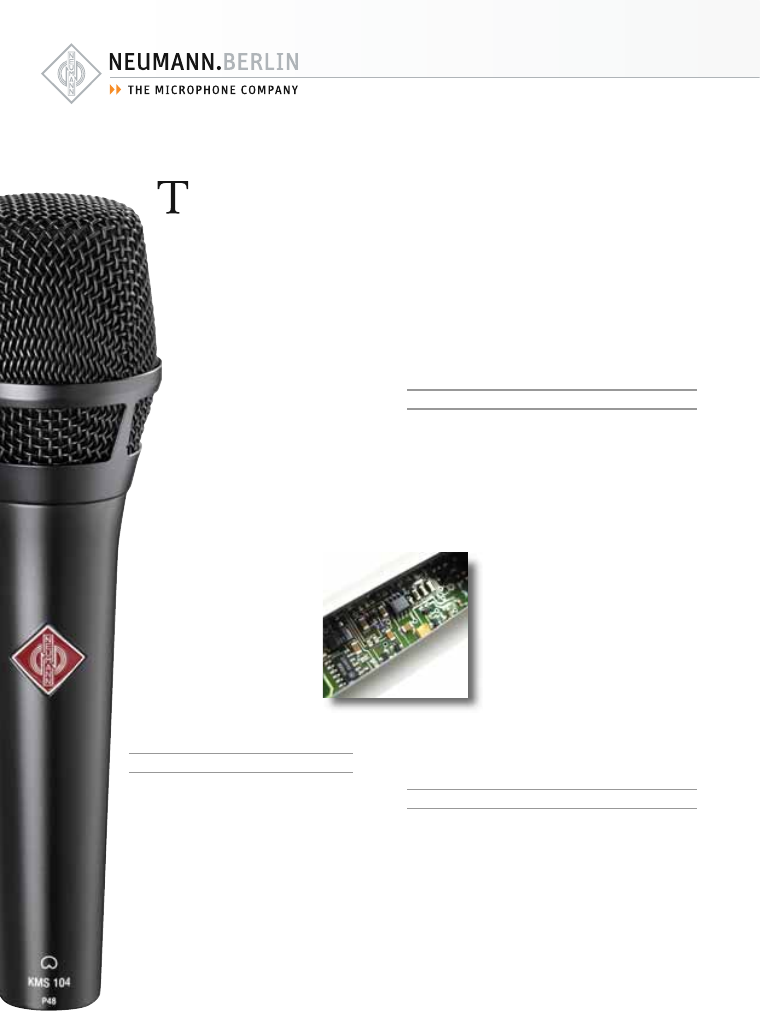
76
he KMS104 and KMS 105 mic-
rophones have been developed to
permit optimal transmission of the
human voice, and are thus micropho-
nes of choice for demanding live ap-
plications. The KMS 105, which has
already been available on the mar-
ket for some time, has become an
internationally recognized standard
in the field of high-quality stage mi-
crophones.
Due to their low self-noise and
crosstalk behavior which is free of
coloration, both microphones are
ideal for use with in-ear monitoring
systems.
The KMS 104 has a microphone cap-
sule with a cardioid directional charac-
teristic which provides the best possib-
le suppression of sounds originating
from behind the microphone. In contrast,
with its supercardioid cha-
racteristic the KMS105 is
particularly good at suppres-
sing sounds originating from
the entire 180° hemisphere
behind the microphone. The
user can thus select the ver-
sion that is optimally suited
to the specific application.
The high acoustic resolution
and smooth frequency re-
sponse of the microphones
ensure that the musician has
optimal control of the stage
performance at all times.
Acoustic features
The studio condenser capsules used in both
microphone versions provide the basis for
transmitting all the nuances of the human
voice. In comparison with other handheld mi-
crophones, which operate mostly with dyna-
mic capsules, the KMS series has a particular-
ly high acoustic transparency, a wide frequen-
cy range and a fine resolution of transients.
In both microphones, carefully adjusted acous-
tic filters and transformerless impedance con-
verters that can handle very high sound pres-
sure levels prevent the microphones from being overloa-
ded even by strong plosive sounds.
In spite of excellent pop protection, sibilants and “S” sounds
are transmitted with their natural accentuation, as is pos-
sible only with condenser microphones. Furthermore, the
above-mentioned acoustic filters are designed so that the
distinctive directional characteristics of the capsules are
preserved even in the bass range. The filters thus ensure a
very high level of feedback protection for the KMS 104 and
KMS 105 vocalist microphones when they are used with a
stage sound system.
Electrical features
Since vocalist microphones are typically addressed at clo-
se range, for the bass frequency response of the micropho-
nes, electronic compensation is used for the proximity ef-
fect in the respective capsules.
In addition, each microphone has an invariable, built-in high-
pass filter with a cutoff frequency of 120Hz (–3dB,
measured in a free sound field). The
dynamic range of the KMS 104/105 is
132dB, and the maximum sound
pressure level is 150dB.
The low self-noise level of only
18 dB-A permits both microphones to
be used at high gain levels without the
risk of additional noise. Even at large
distances, the microphones thus ope-
rate with a high signal-to-noise ratio,
facilitating the freedom of movement
and creativity that are important to the
artist.
Due to the transformerless output cir-
cuit, the microphone signals can be
transmitted even through long cables
without loss of sound.
Mechanical features
Microphones designed for use on stage require a particu-
larly robust construction. The KMS104 and KMS 105
therefore have thick-walled metal housings, which also pro-
vide effective protection against handling noise.
The microphone headgrilles are made of hardened steel. If
required, they can easily be unscrewed to permit cleaning
of the interior acoustic filters.


















